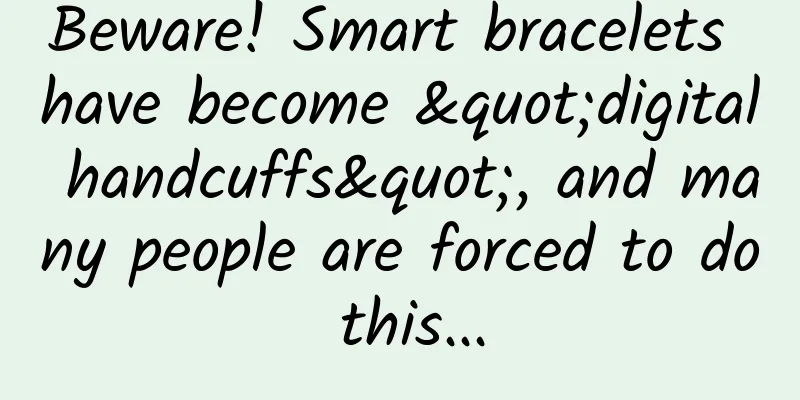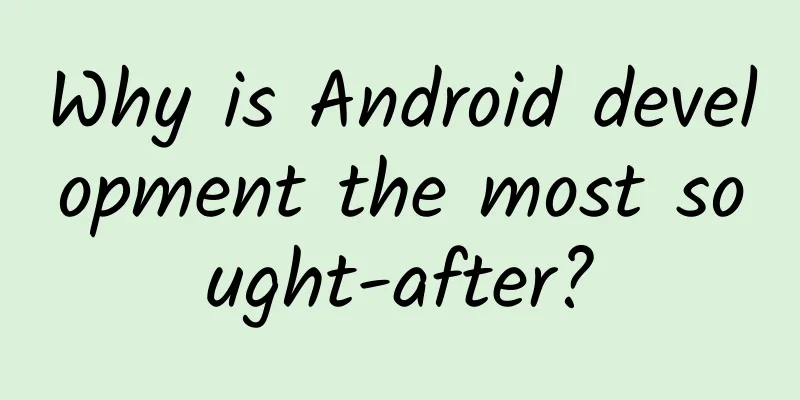Beware! Smart bracelets have become "digital handcuffs", and many people are forced to do this...

|
Health apps don’t make us healthier, they may even make us less happy. Xiaojia (pseudonym), an employee of an e-commerce company in Shanghai, China, was trying to complete a "Perfect Month Challenge" on Apple Watch when I interviewed her. That meant that every day for a month, she had to close the rings on her watch - by completing a series of tasks, including standing up once an hour for 12 hours, burning more than 400 calories, and exercising for 20 minutes. Copyright images in the gallery. Reprinting and using them may lead to copyright disputes. She threw herself into the challenge until early 2022. Due to the pandemic, she was stuck at home and suddenly lost her streak. "The 'fireworks' effect after the closed loop was amazing, and the 'perfect month' was also very attractive," she said. "I worked very hard, made great progress, and set new goals for myself from time to time. But this also became a source of anxiety and stress. Once I couldn't keep up, I would get frustrated and give up. " This love-hate relationship is vivid and common. We learn about ourselves through numbers, and we enjoy the fun parts of self-tracking, but we get frustrated when those self-improvement goals never come true. As some studies have called it, “bittersweet ambivalence,” technological interventions are not all smooth and positive and always have “unsuccessful” parts that convey negative emotional factors. Many self-tracking apps and services want us to feel like progress and reaching goals is a linear, smooth process, but in reality it’s the exact opposite. Xiaojia’s experience of repeatedly setting goals and then giving up is very common. From being "fun" at first, to setting goals and implementing them with enthusiasm, to interruptions, rebounds, and the worst case scenario - giving up completely. Such health-related apps and services have long been struggling with the problem of "compliance" for users to continue using them . And users often blame themselves for not having self-discipline or not being determined enough to change themselves. We would certainly like to make progress, achieve self-actualization, and make every day full of "productivity." But the reason we fail to do these things is not because we are lazy or lack self-discipline. Because our love for health "achievements" is partly due to technology's attempt to turn us into excellent consumers in a marketed health world . Through self-tracking, life is digitized, and our experiences and perceptions are "outsourced" to objectified numbers. Various sensors and apps produce these numbers, and then through various technical designs, they are beautified and packaged into "personal productivity", but at the same time, they ignore the specific context we are in and our identity . The biggest promise of self-tracking apps is that they make exercise easy and frictionless. These apps use countless design tricks that can all be summed up as “nudges” — a psychological term used to describe mechanisms by which people can be lured, coaxed, and subconsciously motivated to do something. Just like the red button on the screen makes users want to click it, the designers believe that similar mechanisms can be used in the field of health to make users "addicted" to these healthy behaviors. Some sound effects after each exercise? Yes. Push notifications to users to complete their daily step count? Yes. An "upgrade" every 10 consecutive days of checking in? Of course, yes. However, life experience often differs from what technology imagines. People with busy schedules and who always work overtime often need health management more, and they want something simpler and more direct, but all the designs that "make things simple and fun" make people feel complicated. All interactions - recording, tracking, celebrating, summarizing, etc. - add extra "work". In my study, more than half of the respondents frequently work overtime, and most of them face various health problems. They recognize that exercise and health are important, and many believe that they need to change their lifestyle. However, the conflicts associated with self-tracking are not only related to lack of time - even if these apps break down your daily goals into "simple" tasks of 15 minutes - but also require a lot of mental resources . The whole concept of self-management, such as quantification of goals, tasks and rewards, continuous recording, regular reminders, etc., are similar to work, which is undoubtedly a kind of hidden labor. Copyright images in the gallery. Reprinting and using them may lead to copyright disputes. These labors are mentally and physically taxing. The relentless progress, constant monitoring and self-monitoring, and interruptions to daily life make self-tracking “difficult.” Pressure from work, pressure from fitness tasks, and the fundamental need for self-management and self-improvement accumulate and reinforce burnout. One interviewee in his 40s described his “stress cycle”, mentioning that fatigue from work was the biggest obstacle to exercising, but the fact that he could not complete simple daily exercise tasks and “lost his way” added a sense of self-blame and failure, which made him fall into deeper distress. These eventually led him to give up his goal and “lie down” helplessly. Why do we still use these apps and struggle to complete tasks even when we are exhausted? Equating health with productivity The idea of becoming a “better self”, of continuous self-improvement, is not new to us. Self-tracking and wearable technology are a powerful example of this belief. We are (seemingly) able to understand and control every aspect of our bodies. Becoming healthier means recording them with quantified numbers, turning daily life and work into challenges and achievements. Studies have shown that quantifying fitness and health overemphasizes external numbers and affects a person's internal motivation. But in today’s productivity culture, the lines between intrinsic and extrinsic value have blurred, as have the lines between work and life, fitness and health, and social and personal value. When we talk about health out of social context and view the body as a work and productivity object, the growth and improvement of numbers becomes part of the self. This productivity culture also fits in with the commercial interests of health technology and its thirst for data. For users, daily numbers are achievements, badges of honor for "self-improvement." Copyright images in the gallery. Reprinting and using them may lead to copyright disputes. For venture-backed internet companies, numbers are a measure of user “value” —how much data can be collected and how many services, memberships, and products can be sold. The design language behind the frenetic narrative of “improvement” and “progress” is that the more users participate, the greater their value in the data “ecosystem.” This business model has potential, but it is not enough to bring stable profits - many once highly valued health technology startups, such as Peloton, have performed poorly in the market. This in turn makes us question our long-standing belief in health technology - whether the model of incorporating fitness and health into productivity is really effective? Does it make sense for us to flatten every lifestyle change into attending classes, customizing plans, and achieving achievements? Add context to numbers One respondent joked that the smart bracelet is a kind of "digital handcuffs." "It does work sometimes," she said with a laugh. Scholars may agree with Foucault's metaphor that self-tracking equals "self-surveillance," how power is embedded in technology so that our bodies can be identified and managed. But in lived experience, the practice of digital health has a richer meaning. What do people talk about when they talk about their numbers? In addition to being caught in a cycle of achievement, the urge to change, and self-blame, self-tracking also provides people with a way to understand their health status from a larger perspective. Our lives and technology are a "co-shaped" relationship. The interaction between people and technology is a two-way bridge. Through technology, we connect ourselves to the social and material context of our daily lives. I asked the respondents to send me screenshots and charts of their self-tracking records and sort out their feelings through these screenshots and data. For example, how did you feel when you saw these numbers? What was going on in your life at that time? What else did you notice in the process of tracking your daily life? This is a process of reconnecting each number with life experience. Compared to self-tracking apps and the monotony of routine, this process can help us realize how changeable and unpredictable our lives are. For example, one respondent recalled that after a stressful day and a conflict with her boss at work, she pushed herself harder on the treadmill. "I watched my heart rate steadily rise, as if I had entered a state where I could control myself and clear my mind." People connected their experiences (both positive and negative) to what was happening in their lives, allowing them to look at their bodies in a new way. One important point many of them mentioned was the connection between their work stress and their physical fluctuations . Self-tracking made them more sensitive to their physical changes, allowing them to sense how their bodies were responding to stress, and to understand when they were not physically active and were not eating well. Some people choose to monitor a few specific metrics and try to keep them at acceptable levels, often doing “less” and reducing the frequency of daily tracking and recording rather than developing a more comprehensive plan. As one respondent recalled, “It was enough to know roughly where I was, the exact number didn’t mean much.” Self-tracking data was recontextualized into life narratives that helped them maintain work-life balance and gain a “self” that they could control , such as “paying attention to my resting heart rate.” In this way, self-tracking became an interface for constructing and understanding the self. Society’s expectations for healthy self-management and the objective conditions that a person must face intersect at this interface. Most self-tracking devices are currently commercial products, driven by data-centric profits and shaping users into efficient and responsible consumers. But what we should learn about self-tracking technology is to focus on lifestyle changes beyond productivity models and place them in the experience of life . In these experiences, data is given multiple meanings and interpretations. It can help people construct their health or disease narratives and reveal the social and structural dilemmas that people struggle with. There is a more valuable potential to use these numbers for our own benefit. References [1] Diefenbach, Sarah. “The Potential and Challenges of Digital Well-being Interventions: Positive Technology Research and Design in Light of the Bitter-sweet Ambivalence of Change.” Frontiers in Psychology 9 (2018): 331. [2] Kelders, Saskia M., Robin N. Kok, Hans C. Ossebaard, and Julia EWC Van Gemert-Pijnen. “Persuasive System Design Does Matter: A Systematic Review of Adherence to Web-Based Interventions.” Journal of Medical Internet Research 14, no. 6 (2012): e152. [3] Ruckenstein, Minna, and Natasha Dow Schüll. “The Datafication of Health.” Annual Review of Anthropology 46 (2017): 261-278. [4] Smith, Gavin JD, and Ben Vonthethoff. “Health By Numbers? Exploring the Practice and Experience of Datafied Health.” Health Sociology Review 26, no. 1 (2017): 6-21. [5] Thaler, Richard H., and Cass R. Sunstein. Nudge: Improving Decisions About Health, Wealth, and Happiness. Penguin, 2009. [6] Lister, Cameron, Joshua H. West, Ben Cannon, Tyler Sax, and David Brodegard. “Just a Fad? Gamification in Health and Fitness Apps.” JMIR Serious Games 2, no. 2 (2014): e3413. [7] Ajana, Btihaj. “Digital Health and the Biopolitics of the Quantified Self.” Digital Health 3 (2017): 2055207616689509. [8] Fors, Vaike, Sarah Pink, Martin Berg, and Tom O'Dell. Imagining Personal Data: Experiences of Self-Tracking. Routledge, 2020. [9] Ruckenstein, Minna. “Charting the Unknown: Tracking the Self, Experimenting with the Digital: Reflection.” In The Palgrave Handbook of the Anthropology of Technology, pp. 253-271. Singapore: Springer Singapore, 2022. References [10] Ajana, Btihaj. “Digital Health and the Biopolitics of the Quantified Self.” Digital Health 3 (2017): 2055207616689509. [11] Diefenbach, Sarah. “The Potential and Challenges of Digital Well-being Interventions: Positive Technology Research and Design in Light of the Bitter-sweet Ambivalence of Change.” Frontiers in Psychology 9 (2018): 331. [12] Fors, Vaike, Sarah Pink, Martin Berg, and Tom O'Dell. Imagining Personal Data: Experiences of Self-Tracking. Routledge, 2020. [13] Kelders, Saskia M., Robin N. Kok, Hans C. Ossebaard, and Julia EWC Van Gemert-Pijnen. “Persuasive System Design Does Matter: A Systematic Review of Adherence to Web-Based Interventions.” Journal of Medical Internet Research 14, no. 6 (2012): e152. [14] Lister, Cameron, Joshua H. West, Ben Cannon, Tyler Sax, and David Brodegard. “Just a Fad? Gamification in Health and Fitness Apps.” JMIR Serious Games 2, no. 2 (2014): e3413. [15] Ruckenstein, Minna. “Charting the Unknown: Tracking the Self, Experimenting with the Digital: Reflection.” In The Palgrave Handbook of the Anthropology of Technology, pp. 253-271. Singapore: Springer Singapore, 2022. [16] Ruckenstein, Minna, and Natasha Dow Schüll. “The Datafication of Health.” Annual Review of Anthropology 46 (2017): 261-278. [17] Smith, Gavin JD, and Ben Vonthethoff. “Health By Numbers? Exploring the Practice and Experience of Datafied Health.” Health Sociology Review 26, no. 1 (2017): 6-21. [18] Thaler, Richard H., and Cass R. Sunstein. Nudge: Improving Decisions About Health, Wealth, and Happiness. Penguin, 2009. Planning and production Author: Dr. Zheng Li, History of Science and Technology Review丨Tang Yicheng, Deputy Director of Beijing Zhongke Popular Psychological Health Promotion Center Planning: Xu Lai, Ding Zong Editors: Ding Zong, Cui Yinghao The cover image and the images in this article are from the copyright library Reprinting may lead to copyright disputes |
<<: The bathroom is so small, why is the WiFi signal always so bad?
>>: Magnesite: This is a stone that can be used to weave cloth?
Recommend
Google's "AI Guess the Picture" app is popular on WeChat Moments: user participation makes it smarter
One day after its launch, Google's first WeCh...
What should I do if GuangDianTong and Moments don’t work well?
There are countless channels for information flow...
Thoroughly understand the "shadow" in Android MD design
[[220766]] If we want to create better Android ap...
Guangdiantong information flow operation guide, very detailed
Among the current mainstream information flow cha...
Labelled as "designed for babies", but using fake salmon? Here are 26 types of fish tested!
So infuriating! Some time ago, we tested a wave o...
Practice KOL marketing from 0 to 1!
KOL, the full name of which is Key Opinion Leader...
Why don't woodpeckers get concussions even though they peck so hard?
Welcome to the 13th issue of the Nature Trumpet c...
Unveiling the Secrets of DeepGlint: How Do Computers Understand Our World?
[[124218]] Do you find a white A4 paper on the wh...
15 days to boost store traffic, applicable to all restaurants, a must-learn to break through the bottleneck of order volume
15 days to boost store traffic, applicable to all...
"Delivering express", "negotiating cooperation", "macro-control", they are the best employees for plant factories!
Produced by: Science Popularization China Author:...
Still worried about AirPods being lost? A brooch can help
Apple's first truly wireless earphone product ...
5 thoughts on community operations!
Before the rapid development of mobile Internet, ...
What aspects should companies consider before developing an APP?
Nowadays, all enterprises are moving towards mobi...
Internet videos boost the popularity of TV boxes, but it is difficult to balance control and content
With the popularization of the Internet, more and...
Activity operation sandbox/activation engine
We have talked about so many recommendation algor...









